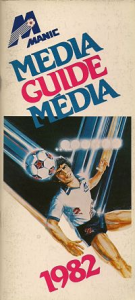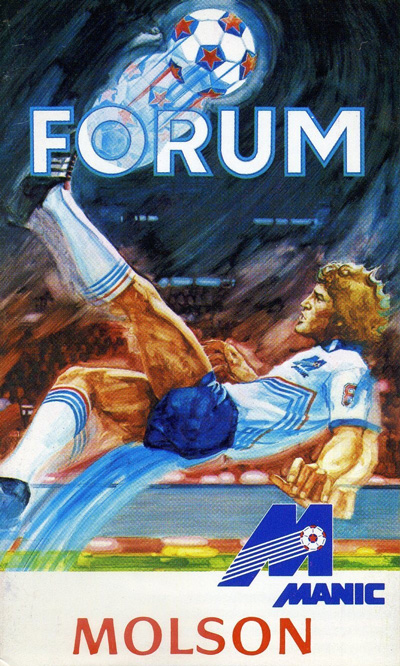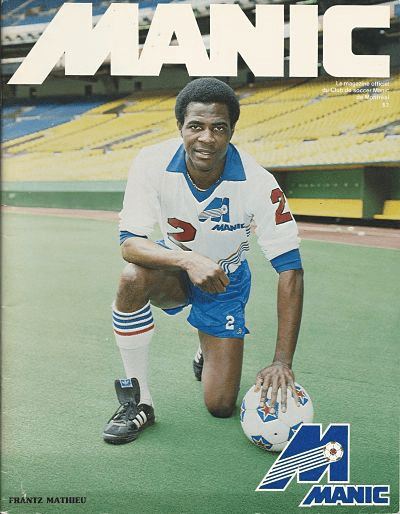North American Soccer League (1981-1983)
Tombstone
Born: October 1980 – The Philadelphia Fury relocate to Montreal
Folded: November 1983
First Game: June 2, 1981 (L 2-1 vs. New York Cosmos)
Last Game: September 28, 1983 (L 3-0 @ Tulsa Roughnecks)
Soccer Bowl Championships: None
Stadia
Outdoor Soccer:
Olympic Stadium (58,693)11983 Official North American Soccer League Guide
Opened: 1976
Indoor Soccer:
The Montreal Forum
Opened: 1924
Closed: 1996
Branding
Team Colors: White, Blue & Red21983 Official North American Soccer League Guide
Ownership
Owner: Molson Breweries (Morgan McCammon, Chairman)
Attendance
Tilting your mobile device may offer better viewing.
Outdoor Attendance:
Source: Kenn.com Attendance Project
Background
 Let’s start with the name. The Montreal Manic – or Le Manic de Montreal for its Francophone supporters – was not named after a mental health disorder characterized by mood swings, unpredictability and frenzied activity. That would be a sensible assumption. This was, after all, the franchise formerly known as the Philadelphia Fury. But in fact the Montreal Manic soccer club took its name from something far stranger…the Manic-1 hyrdoelectric dam at the mouth of Quebec’s Manicouagan River.
Let’s start with the name. The Montreal Manic – or Le Manic de Montreal for its Francophone supporters – was not named after a mental health disorder characterized by mood swings, unpredictability and frenzied activity. That would be a sensible assumption. This was, after all, the franchise formerly known as the Philadelphia Fury. But in fact the Montreal Manic soccer club took its name from something far stranger…the Manic-1 hyrdoelectric dam at the mouth of Quebec’s Manicouagan River.
The Manic formed in October/November 1980. Molson Breweries – owners of the NHL’s Montreal Canadiens – bought into the struggling North American Soccer League for a reported price of just over $2 million dollars. For their two million bucks, Molson got arguably the worst franchise in the league. The three-year old Philadelphia Fury were coming off a 10-22 last place finish in 1980. Their paltry average attendance of 4,465 was the worst in the league. (The famed New York Cosmos, by comparison, averaged 42,754 in 1980).
Molson’s investment was a godsend for the shrinking NASL. The league was in the midst of a painful correction following a period of reckless expansion during the late 1970’s. The league peaked at 24 teams in 1980, but just one day before Molson officials announced the team’s arrival in Montreal, the NASL’s Houston, Rochester and Washington clubs folded. The loss of the Washington Diplomats was particularly galling. The Dips had rich owners, a world superstar in Johan Cruyff of Holland, and had just hosted Soccer Bowl ’80 at RFK Stadium before nearly 50,000 fans. ABC was also unhappy with its puny TV ratings for the NASL. The network announced it would not broadcast any games in the final year of its contract in 1981 except for the Soccer Bowl championship.
Making the Manic
The Manic retained Fury Head Coach Eddie Firmani, the winningest coach in league history despite 1980’s last place finish. Firmani was the only coach to lead two different clubs to the Soccer Bowl title, winning with the Tampa Bay Rowdies (1975) and twice with the Cosmos (1977 and 1978). Other Fury holdovers included the American goalkeeper Bob Rigby (who would start all 32 games for Montreal in 1981), defenders Andy Lynch and Bob Vosmaer, and midfielder Fran O’Brien and Andy Parkinson.
The Manic added rookie scoring star Thompson Usiyan through the college draft. They also picked up English striker Gordon Hill who would lead the club with 16 goals and 12 assists in 1981. Long-time NASL scoring star Alan Willey joined Montreal in a mid-season trade with the Minnesota Kicks.
The Manic debuted at Montreal’s Olympic Stadium on April 18th, 1981. A crowd of 27,060 watched Andy Parkinson score two goals to lead the Manic to a 2-1 victory over the Toronto Blizzard. Enthusiasm for the team built throughout the summer. 38,667 turned out to see the NASL’s biggest draw – the Cosmos – on June 2nd. A crowd of 40,000+ showed up for the Cosmos’ return visit in late July and the Manic drew a season-high of 50,755 to the regular season finale on August 18th.

Bandwagon Days
The Manic eeked into the 1981 NASL playoffs with a 15-17 record and the crowds got even stronger. 46,682 came out to cheer the Manic in a 1st round match against the Los Angeles Aztecs on August 24th. The Manic drew a club record 58,542 for the opening game of the quarterfinals against the Chicago Sting on September 2, 1981. They rewarded the hometown fans with a 3-2 victory. But the Sting would win the next two games in Chicago to eliminate the Manic.
A 1981 profile in Sports Illustrated, which featured a comic scene of ex-pat Italian waiters fawning over a table of Manic players in a Montreal restaurant, captured the melting pot appeal of the Manic during the team’s early days. Nevertheless, the Manic front office’s attitude towards non-French speaking fans was shockingly dismissive, particularly for a cosmopolitan city that hosted the Olympics just five years earlier:
“We haven’t spent a cent on the ethnics,” a team spokesman told SI.3Gammon, Clive. “Manic But Not Depressive.” Sports Illustrated. June 15, 1981 “They can yap and yell that they know the sport from back in Italy or Romania, but we want to build something special for us Quebecois.”
From November 1981 to February 1982 the Manic played in the NASL’s wintertime indoor soccer league, making their home at the Montreal Forum. The indoor game proved popular in Montreal as well, with peak attendance coming on January 29th, 1982 when 13,125 fans turned out at the Forum to watch the Manic defeat the Cosmos 11-6.
1982 Season
The Manic returned outdoors in April 1982 for what would be the best season of their short history. The campaign got off to an inauspicious start. Star striker Gordon Hill was vocally unhappy with Canada’s tax system and demanded a trade during the indoor season. The Manic accomodated Hill shortly into the outdoor campaign by trading him to the Chicago Sting for defender Frantz Mathieu. Mathieu who would go onto to make the NASL All-Star Team for Montreal. Alan Willey picked up the scoring slack from Hill, netting 15 goals. Victor Nogueira took over the bulk of the goalkeeping duties from Bob Rigby. The Manic finished 19-13, but fell to the Ft. Lauderdale Strikers in the first round of the playoffs.
1982 attendance dipped imperceptibly to an average of 21,438, second best to the Cosmos for the second straight year.
Team Canada Concept
The turning point for the Manic franchise came in February 1983. NASL President Howard Samuels championed the creation of an expansion team in Washington, D.C. for the 1983 season to be known as Team America. Team America was to be a club version of the U.S. National Team, featuring all of the top young American players from around the NASL. Playing as a club side in the NASL would help the U.S. team develop with a goal of qualifying for the 1986 World Cup in Mexico. Seizing on the idea, Samuels, Molson Chairman Morgan McCammon and the Canadian Soccer Association announced that the Manic would transform itself into Team Canada by the 1984 season. The cluub would gradually trade away its foreign players and replace them with top Canadians from around the NASL.
The concept went horribly awry for both teams. Many of the NASL’s top Americans refused to leave their existing clubs to join an expansion team with uncertain prospects. Team America ended up finishing last in the NASL in 1983 and folding. Montreal was in an even tougher situation. Here was a winning, established club with a dedicated fan base under public instruction to dismantle itself.

Demise
Unsurprisingly, the Montreal fan base revolted. Season ticket sales for the 1983 season dropped by more than 50% from 1982 levels. Overall attendance collapsed to 9,910 per game, tenth out of the NASL twelve clubs in 1983, after two seasons of trailing only the New York Cosmos. Win or lose, the Manic were a lame duck team and local fans saw no reason to support them.
The Manic earned a playoff berth on the final day of the 1983 season. This despite a 12-18 record and a last place finish in the NASL’s Eastern Division. The team then proceeded to shock the 22-8 New York Cosmos, sweeping a best-of-three series. The Manic’s upset victory snapped a string of four consecutive Soccer Bowl appearances for the Cosmos. The decisive Game Two drew 20,726 to Olympic Stadium. It was the less than the club’s 1982 average, but nevertheless marked the largest crowd of the 1983 season in Montreal. The Manic bowed in the semi-final round to the eventual champion Tulsa Roughnecks.
Molson pulled the plug on the Manic during the first week of November 1983. The brewery cited losses of $10 million over three seasons and admitted the Team Canada concept had been a disaster that obliterated the Manic fan base.
The NASL played one more season and then went out of business in early 1985.
Montreal Manic Shop
Editor's Pick
Rock n' Roll Soccer
The Short Life and Fast Times of the North American Soccer League
by Ian Plenderleith
The North American Soccer League – at its peak in the late 1970s – presented soccer as performance, played by men with a bent for flair, hair and glamour. More than just Pelé and the New York Cosmos, it lured the biggest names of the world game like Johan Cruyff, Franz Beckenbauer, Eusebio, Gerd Müller and George Best to play the sport as it was meant to be played-without inhibition, to please the fans.
The first complete look at the ambitious, star-studded NASL, Rock ‘n’ Roll Soccer reveals how this precursor to modern soccer laid the foundations for the sport’s tremendous popularity in America today.
When you make a purchase through an affiliate link like this one, Fun While It Lasted earns a commission at no additional cost to you. Thanks for your support!
[auction-nudge tool=”listings”]
Montreal Manic Video
Manic host the Toronto Blizzard at Olympic Stadium, April 18, 1981
1983 NASL playoffs Manic vs. New York Cosmos at Olympic Stadium. French language broadcast.
In Memoriam
Former Molson Breweries and Manic chairman Morgan McCammon passed away on November 20, 1999 at the age of 77.
Forward Thompson Usiyan passed away on August 31st, 2021. The Nigerian-born striker scored 21 goals for Le Manic during the 1981 and 1982 outdoor seasons. Usiyan was 65 years old.
Downloads
6-2-1981 Manic vs. New York Cosmos Game Preview (English)
6-2-1981 Montreal Manic vs New York Cosmos Game Preview (English)
6-2-1981 Manic vs. New York Cosmos Game Notes (French)
6-2-1981 Manic vs. New York Cosmos Game Operations Timing Sheet
7-22-1981 Manic @ New York Cosmos Game Notes (French)
8-16-1981 Manic @ New York Cosmos Game Notes (English)
6-18-1982 Manic and Cosmos Resume Rivalry Press Release (English)
6-18-1982 Le Manic and Cosmos Resume Rivalry Press Release (French)
6-18-1982 Manic vs. New York Cosmos Game Notes (French)
8-20-1982 Manic vs. New York Cosmos Game Notes (English)
8-20-1982 Manic vs. New York Cosmos Game Notes (French)
8-14-1983 Manic vs. New York Cosmos Game Notes (French)
Links
###



3 Responses
Great summary. I’d like to add that as a 14 year old member of the Thompson Usiyan Fan club I got season tickets to the indoor season at a heavenly discounted price. Membership does have it’s advantages. Also the Manic drew 17K to it’s indoor play-off clash with Tampa Bay. Tampa won the first game in Tampa and the Manic won at the Forum. Then to everyone’s surprise a 30 minute mini game was help with Tampa winning 2-1 to advance. A goal by Tatu if I remember.
It was the best 3 hours I have ever spent at a sporting event and I have been to many many. The place as they say was jumping hot.
Sorry to say Thompson Usiyan passed away on August 31, 2021. A sad day for Manic fans.
I was in the group Les Maniciennes du Manic de Montreal.
We played the national anthem at the beginning of the game